基于wordpress搭建个人网站(linux)-九游平台
应用场景
本文主要介绍了如何使用弹性云服务器的linux实例手工搭建lnmp平台,并部署wordpress环境。wordpress简称wp,最初是一款博客系统,后逐步演化成一款免费的cms(内容管理系统/建站系统)。该指导具体操作以centos 7.2 64位操作系统为例。
操作视频
方案架构
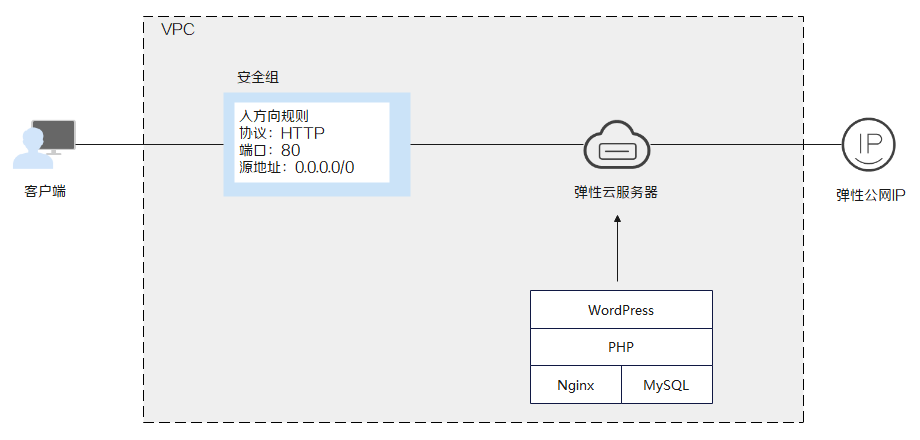
方案优势
- 快速构建站点,组网架构简单。
- 网站安全易用。
资源和成本规划
资源 |
资源说明 |
成本说明 |
|---|---|---|
虚拟私有云vpc |
vpc网段:192.168.0.0/16 |
免费 |
虚拟私有云子网 |
|
免费 |
安全组 |
入方向规则:
|
免费 |
弹性云服务器 |
|
ecs涉及以下几项费用:
具体的计费方式及标准请参考。 |
nginx |
是一个高性能的http和反向代理web服务器。 获取方式: |
免费 |
mysql |
是一款开源的关系数据库软件。 获取方式: |
免费 |
php |
是一款开源软件,用于web开发。 获取方式: |
免费 |
wordpress |
是一款开源的博客软件。 获取地址: |
免费 |
域名 |
用于访问搭建的个人网站。 |
域名的价格以域名注册商所示为准,请参考域名注册商帮助文档。 如果您通过华为云的域名注册服务购买域名,具体的计费方式及标准请参考。 |
基于wordpress搭建个人网站操作流程
实施步骤(自动)
实施步骤(手动)
安装前准备
- 已购买虚拟私有云和弹性公网ip。
- 如果规划为网站配置域名,需已经购买好相应的域名。
- 弹性云服务器所在安全组添加了如表2所示的安全组规则,具体步骤参见。
表2 安全组规则 方向
协议
端口
源地址
入方向
http(80)
80
0.0.0.0/0
- 为了更好的获取和更新系统和软件,建议您更新镜像源为华为云镜像源,详细操作,请参见。
操作步骤
- 安装nginx。
- 登录弹性云服务器。
- 执行以下命令,下载对应当前系统版本的nginx包。
wget http://nginx.org/packages/centos/7/noarch/rpms/nginx-release-centos-7-0.el7.ngx.noarch.rpm
- 执行以下命令,建立nginx的yum仓库。
rpm -ivh nginx-release-centos-7-0.el7.ngx.noarch.rpm
- 执行以下命令,安装nginx。
yum -y install nginx
- 执行以下命令,启动nginx并设置开机启动。
systemctl start nginx
systemctl enable nginx
- 查看启动状态。
systemctl status nginx.service
- 使用浏览器访问 “http://服务器弹性公网ip地址”,显示如下页面,说明nginx安装成功。
图2 测试访问nginx
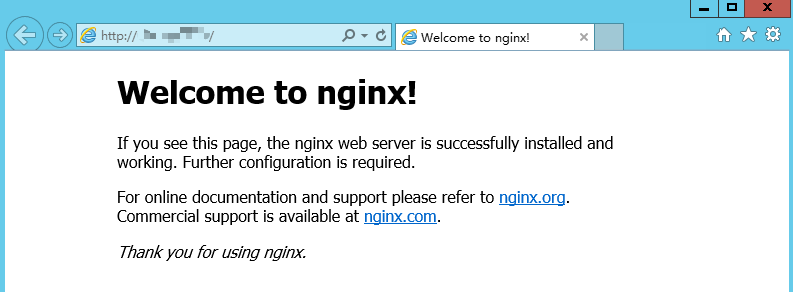
- 安装mysql。
- 依次执行以下命令,安装mysql。
wget -i -c http://dev.mysql.com/get/mysql57-community-release-el7-10.noarch.rpm
yum -y install mysql57-community-release-el7-10.noarch.rpm
yum -y install mysql-community-server --nogpgcheck
- 依次执行以下命令,启动mysql服务并设置开机自启动。
systemctl start mysqld
systemctl enable mysqld
- 查看mysql运行状态。
systemctl status mysqld.service
[root@ecs-adc3 ~]# systemctl status mysqld.service ● mysqld.service - mysql server loaded: loaded (/usr/lib/systemd/system/mysqld.service; enabled; vendor preset: disabled) active: active (running) since mon 2021-08-16 19:33:40 cst; 36s ago docs: man:mysqld(8) http://dev.mysql.com/doc/refman/en/using-systemd.html main pid: 7916 (mysqld) cgroup: /system.slice/mysqld.service └─7916 /usr/sbin/mysqld --daemonize --pid-file=/var/run/mysqld/mysqld.pid aug 16 19:33:35 ecs-adc3 systemd[1]: starting mysql server... aug 16 19:33:40 ecs-adc3 systemd[1]: started mysql server. - 执行以下命令,获取安装mysql时自动设置的root用户密码。
grep 'temporary password' /var/log/mysqld.log
回显如下类似信息。2021-08-16t11:33:37.790533z 1 [note] a temporary password is generated for root@localhost: ;8npd29lhs,k
- 执行以下命令,并按照回显提示信息进行操作,加固mysql。
mysql_secure_installation
securing the mysql server deployment. enter password for user root: #输入上一步骤中获取的安装mysql时自动设置的root用户密码 the existing password for the user account root has expired. please set a new password. new password: #设置新的root用户密码 re-enter new password: #再次输入密码 the 'validate_password' plugin is installed on the server. the subsequent steps will run with the existing configuration of the plugin. using existing password for root. estimated strength of the password: 100 change the password for root ? ((press y|y for yes, any other key for no) : n #是否更改root用户密码,输入n ... skipping. by default, a mysql installation has an anonymous user, allowing anyone to log into mysql without having to have a user account created for them. this is intended only for testing, and to make the installation go a bit smoother. you should remove them before moving into a production environment. remove anonymous users? (press y|y for yes, any other key for no) : y #是否删除匿名用户,输入y success. normally, root should only be allowed to connect from 'localhost'. this ensures that someone cannot guess at the root password from the network. disallow root login remotely? (press y|y for yes, any other key for no) : y #禁止root远程登录,输入y success. by default, mysql comes with a database named 'test' that anyone can access. this is also intended only for testing, and should be removed before moving into a production environment. remove test database and access to it? (press y|y for yes, any other key for no) : y #是否删除test库和对它的访问权限,输入y - dropping test database... success. - removing privileges on test database... success. reloading the privilege tables will ensure that all changes made so far will take effect immediately. reload privilege tables now? (press y|y for yes, any other key for no) : y #是否重新加载授权表,输入y success. all done!
- 依次执行以下命令,安装mysql。
- 安装php。
- 执行以下命令,安装epel源。
yum -y install epel-release
- 执行以下命令,安装remi源。
yum -y install http://rpms.remirepo.net/enterprise/remi-release-7.rpm
- 执行以下命令,安装yum源管理工具。
yum -y install yum-utils
- 执行以下命令,安装php 7.4。
yum -y install php74-php-gd php74-php-pdo php74-php-mbstring php74-php-cli php74-php-fpm php74-php-mysqlnd
- 执行以下命令,验证php的安装版本。
php74 -v
回显如下类似信息:
php 7.4.33 (cli) (built: jun 6 2023 15:55:08) ( nts ) 九游平台 copyright (c) the php group zend engine v3.4.0, 九游平台 copyright (c) zend technologies
- 执行以下命令,启动php服务并设置开机自启动。
systemctl start php74-php-fpm
systemctl enable php74-php-fpm
- 修改nginx配置文件以支持php。
- 执行以下命令打开配置文件/etc/nginx/nginx.conf。
vim /etc/nginx/nginx.conf图3 nginx.conf
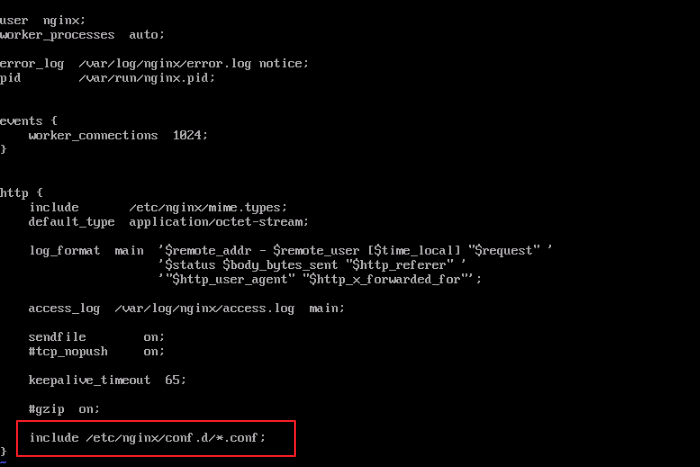
从nginx.conf可以看出,配置文件定向至/etc/nginx/conf.d/*.conf。
- 输入:quit退出nginx.conf。
- 执行以下命令打开配置文件/etc/nginx/conf.d/default.conf。
vim /etc/nginx/conf.d/default.conf
- 按i键进入编辑模式。
- 修改打开的“default.conf”文件。
找到server段落,修改或添加下列配置信息。
server { listen 80; server_name localhost; #access_log /var/log/nginx/host.access.log main; location / { root /usr/share/nginx/html; index index.php index.html index.htm; } location ~ \.php$ { root html; fastcgi_pass 127.0.0.1:9000; fastcgi_index index.php; fastcgi_param script_filename /usr/share/nginx/html$fastcgi_script_name; include fastcgi_params; }如图4所示:
图4 修改后截图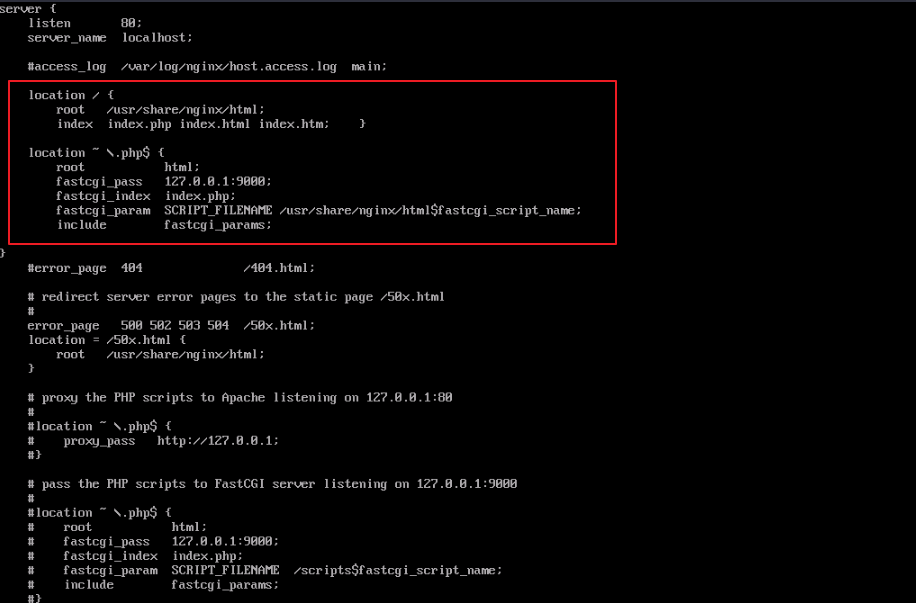
- 按esc键退出编辑模式,并输入:wq保存后退出。
- 执行以下命令打开配置文件/etc/nginx/nginx.conf。
- 执行以下命令,重新载入nginx的配置文件。
service nginx reload
- 执行以下命令,安装epel源。
- 浏览器访问测试。
- 在/usr/share/nginx/html目录下创建“info.php”的测试页面。
- 执行以下命令创建并打开“info.php”的测试文件。
vim /usr/share/nginx/html/info.php
- 按i键进入编辑模式。
- 修改打开的“info.php”文件,将如下内容写入文件。
- 按esc键退出编辑模式,并输入:wq保存后退出。
- 执行以下命令创建并打开“info.php”的测试文件。
- 使用浏览器访问“http://服务器ip地址/info.php”,显示如下页面,说明环境搭建成功。
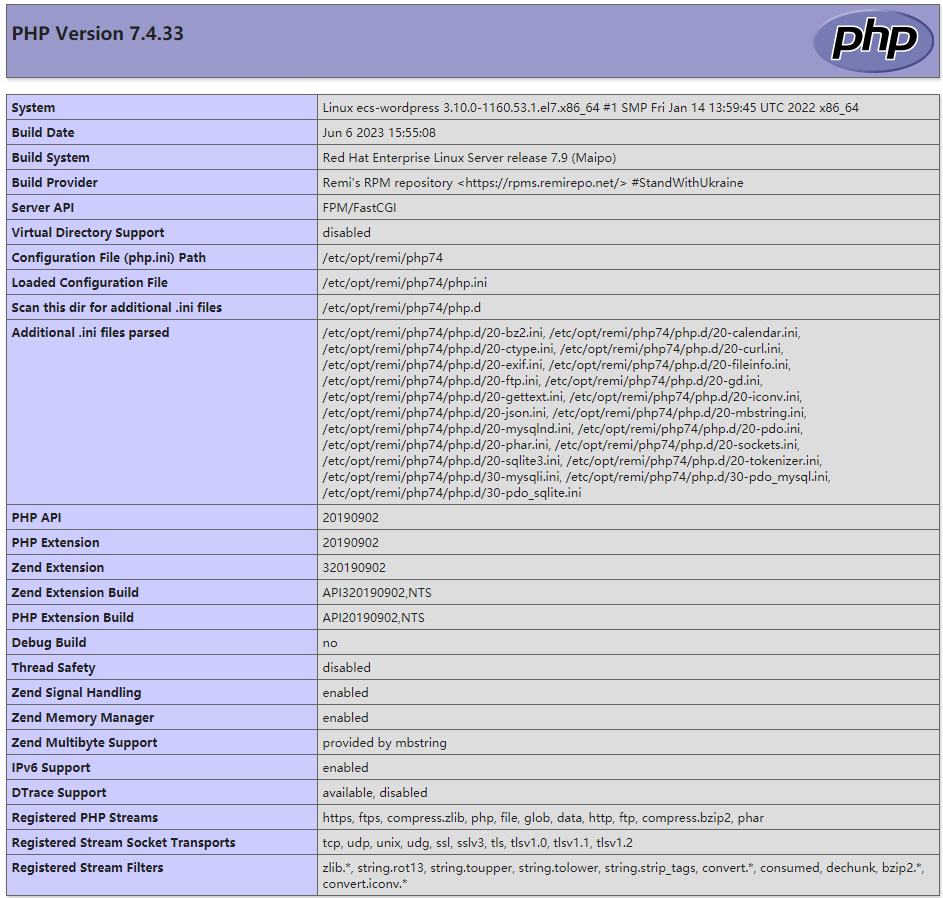
- 在/usr/share/nginx/html目录下创建“info.php”的测试页面。
- 创建数据库。
- 执行以下命令,并按照提示信息输入mysql的root用户,登录到mysql命令行。
mysql -u root -p
- 执行以下命令,创建一个新的数据库。
create database wordpress;
其中,“wordpress”为数据库名,可以自行设置。
- 执行以下命令,为数据库创建用户并为用户分配数据库的完全访问权限。
grant all on wordpress.* to wordpressuser@localhost identified by 'xxxxx';
其中,“wordpressuser”为数据库用户名,“xxxxx”为对应的账户密码,可以自行设置。
- 执行以下命令,退出mysql命令行。
exit
- (可选)依次执行以下命令,验证数据库和用户是否已成功创建,并退出mysql命令行。
mysql -u wordpressuser -p
show databases;
exit
其中,“wordpressuser”为刚刚创建的数据库用户名。
- 执行以下命令,并按照提示信息输入mysql的root用户,登录到mysql命令行。
- 安装wordpress。
- 请自行获取wordpress软件包并上传至/usr/share/nginx/html目录。操作方法请参见。
后续操作软件包以“wordpress-6.4.2-zh_cn.tar.gz”为例。
- 执行以下命令,进入/usr/share/nginx/html/目录,解压缩软件包。
cd /usr/share/nginx/html
tar zxvf wordpress-6.4.2-zh_cn.tar.gz
解压后生成一个“wordpress”的文件夹。
- 执行以下命令,进入 wordpress 安装目录,将wp-config-sample.php文件复制到wp-config.php文件中,并将原先的示例配置文件保留作为备份。
cd /usr/share/nginx/html/wordpress
cp wp-config-sample.php wp-config.php
- 执行以下命令,打开并编辑新创建的配置文件。
vim wp-config.php
- 按i键进入编辑模式。找到文件中mysql的部分,并将相关配置信息修改为步骤5中的内容。
图5 修改mysql配置
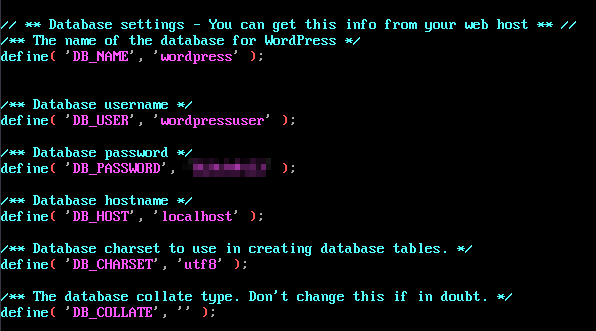
- 按esc键退出编辑模式,并输入:wq保存后退出。
- 浏览器访问“http://服务器ip地址/wordpress”进入安装向导。
图6 安装向导
- 设置站点标题、管理员账号、密码和邮箱,并单击“安装 wordpress”。
表3 配置参数 参数
说明
站点标题
wordpress网站名称。
用户名
wordpress管理员名称。
密码
可以使用默认的密码或者自定义密码。
请勿重复使用现有密码,并确保将密码保存在安全的位置。
您的电子邮箱地址
接收通知的电子邮件地址。
- 安装完成后,弹出安装成功界面。
图7 安装成功
- 单击“登录”,或者浏览器访问“http://服务器ip地址/wordpress/wp-login.php”,输入用户名/电子邮箱地址和密码后单击“登录”,进入wordpress。
图8 登录wordpress
图9 进入wordpress界面
- 请自行获取wordpress软件包并上传至/usr/share/nginx/html目录。操作方法请参见。
- 购买域名。
为了便于网站的访问和使用,可以给网站设置一个单独的域名,使用域名访问网站。您可以在中购买域名,具体步骤请参考。
- 进行备案。
如果网站未进行备案,且需要使用华为云进行托管,则需要通过华为云备案系统进行备案。具体操作请参见。
- 配置域名解析。
配置域名解析后才能使用注册的域名访问网站。具体操作请参见。
例如,配置的域名为“www.example.com”,配置成功后,可在浏览器地址栏中输入“http://www.example.com”访问部署的网站。
相关文档
意见反馈
文档内容是否对您有帮助?
如您有其它疑问,您也可以通过华为云社区问答频道来与我们联系探讨




